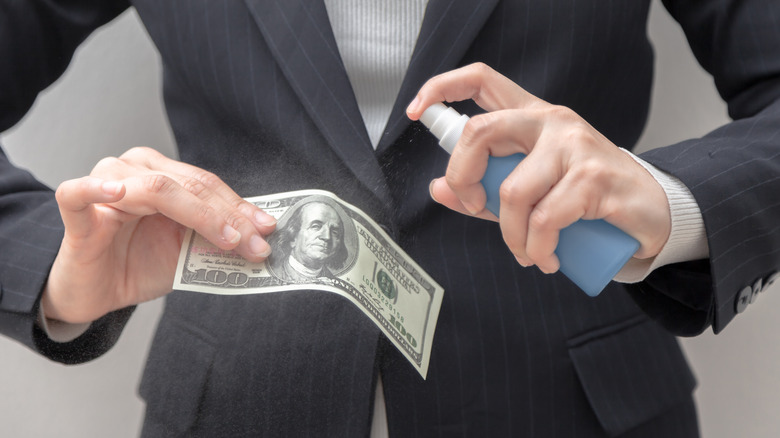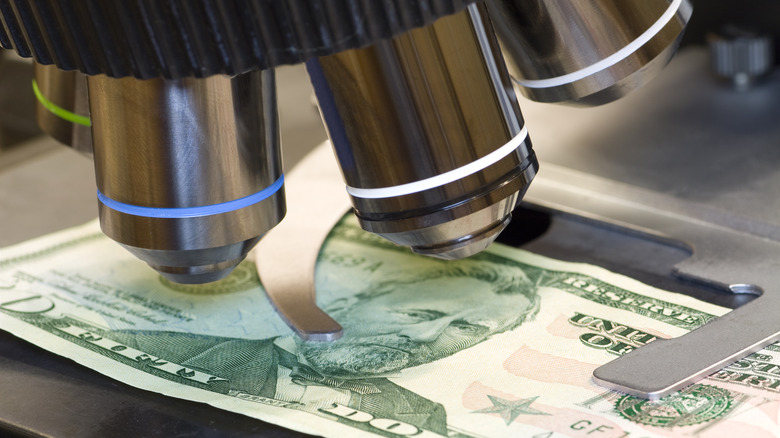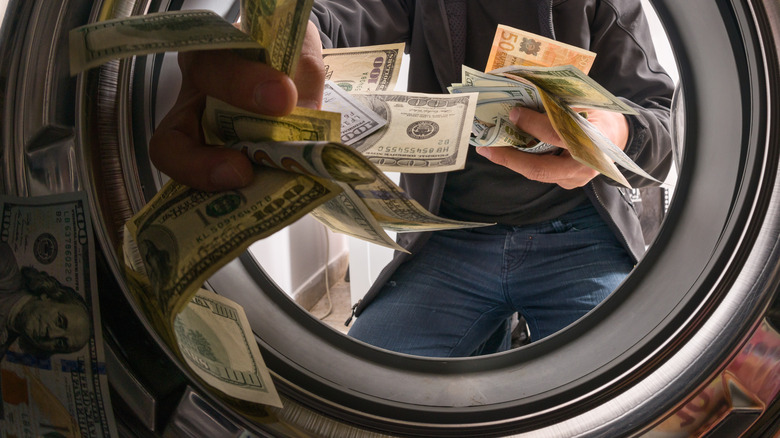Your Money Is Way Filthier Than You Can Even Comprehend
With the increasing popularity of contactless credit cards and digital wallets like Apple Pay and Google Pay, there's no denying that the United States and the world are moving toward a cashless society. Besides the obvious convenience of transitioning to digital payments, it could also have a positive effect on your health because traditional currency — both paper notes and coins — are downright filthy. Although we call it paper money, U.S. currency notes are actually comprised of 75% cotton and 25% linen, which is the perfect environment for germs and microbes to call a comfy home. In fact, a Chicago Tribune study found that over 90% of the bills they tested contained bacteria.
Fortunately, temperature and moisture conditions aren't ideal for the microbes to thrive, so they mostly just hang out in paper currency's porous surface. Even if microbes like bacteria do rub off on your hands, they're unlikely to cause any real harm. In comments to Time Magazine, assistant professor at the University of Michigan, Emily Martin, says, "Even if some microbes do come off on your hands, they're unlikely to hurt you there." Martin continues, "You don't want to introduce bacteria into areas of the body that have less protection, but our skin is a really good protector."
So what exactly is on your money?
In a 2017 study by the journal Plos One, researchers analyzed a cross-section of $1 bills from a bank in New York City which alarmingly identified hundreds of different types of microorganisms. Among the most abundant were the microorganism that causes acne, harmless skin bacteria, and DNA from pets.
Germs aren't the only thing you'll find on paper money — they're also frequently carrying small amounts of drugs, which makes sense when you consider the cash-heavy nature of the illicit drug business. Specifically, a study of $1 bills from across the country revealed that 80% had trace quantities of cocaine present.
According to the U.S. Currency Education Program, the average life expectancy of paper money is approximately five years to more than 20 years, depending on the denomination. With such a long lifespan, cleaning currency using chemicals and/or high temperatures is something that's been investigated by scientists, as was switching to a plastic polymer material, which has proven cleaner in other countries like Canada and Australia. Ultimately, the risk wasn't great enough to warrant the expense and hassle of taking action, especially considering how dirty other everyday surfaces are, such as handrails.
Coins are cleaner than bills, but not by much
A recent LendEDU study tested bacteria on a variety of payment methods to learn which are the dirtiest. The unit of measure was the "germ score" and for reference, an establishment serving food is expected to have a germ score of 10 or less for its surfaces to be considered clean. Paper currency had an average score of 160, with $5 bills being the dirtiest and $100 bills being the least germy. An assortment of coins had an average germ score of 136. For the record, dimes were the dirtiest, while quarters were the cleanest.
Before you go throwing all of your cash and coins into the washing machine for a deep cycle, also consider that a New York City park bench registered a germ score of 503, while the handlebars of a Citi Bike rental bicycle clocked in with a germ score of 758. According to experts, the best way to protect yourself from germs in general is to wash your hands frequently, especially before eating. If you really want to pay it forward, you can also wash your hands after eating to reduce contribution of your own microorganisms into the money pool while settling the check for your meal.


